Affordable Landscaping Ideas for Large Backyards


Intro
Landscaping a large backyard can seem overwhelming, especially when budget constraints are a concern. However, with careful planning and a focused approach, homeowners can create an outdoor space that is both attractive and functional without breaking the bank. This guide aims to provide practical and cost-effective strategies that highlight various aspects ranging from initial design concepts to the selection of materials and plants. Each section will offer insights that help achieve a beautiful garden that reflects personal style while being financially sustainable.
Adding value to your property and improving your quality of life can be done through landscaping. Understanding the essentials of landscape planning will help make informed choices that align with both your aesthetic vision and budget limitations. This article is structured to guide you step-by-step through the landscaping process. By emphasizing creativity and resourcefulness, you can transform a large backyard into a vibrant interconnected space.
Design Inspiration
Designing a large backyard requires an understanding of not only current trends but also the character of the space itself. It’s important to have a vision that combines your personality with functionality.
Current Trends in Landscaping
Present-day landscaping trends focus on natural elements and sustainability. Here are some insightful approaches:
- Native Plants: Incorporating local flora can reduce maintenance costs and enhance biodiversity. They require less water and are naturally adapted to the local climate.
- Xeriscaping: This practice minimizes the need for irrigation by utilizing drought-resistant plants. It is ideal for regions with limited water supply.
- Outdoor Living Spaces: These allow for an extension of your home’s living area. Patios, fire pits, and kitchens enhance utility.
Color Schemes and Palette Ideas
Selecting the right colors can greatly influence the mood of your backyard. Consider these inspirations:
- Earth Tones: Warm browns, greens, and neutral shades create a grounded, calming effect.
- Bold Accents: Introduce bright flowers or decorative pots in vibrant hues for a striking contrast.
- Monochromatic Themes: A palette focusing on varying shades of a single color can create a cohesive and sophisticated look.
A well-thought-out landscaping design not only enhances the visual appeal but also contributes to functionality. Careful consideration of current trends and appropriate color schemes is crucial.
"Effective landscape design is not just about aesthetics; it is an integration of nature and functionality."
Adopting these design principles offers a structured framework to approach your backyard’s transformation. By doing so, you ensure that every aspect contributes meaningfully to the overall environment.
Gardening Techniques
Effective gardening is foundational for a thriving backyard. Understanding proper techniques can set the tone for a vibrant landscape.
Plant Selection and Care
Choosing the right plants is vital. Opt for species that require minimal maintenance and suit your climate. Some key considerations include:
- Hardiness: Select plants that can thrive in your zone to minimize care.
- Water Requirements: Consider plants that are drought-resistant if water conservation is a goal.
- Seasonal Interest: Include a mix of evergreen and flowering plants for varied visual appeal throughout the year.
Regular maintenance practices like mulching, watering, and pest control will keep your plants healthy and thriving. With proper care, your selected flora will flourish and enhance your space.
Indoor vs. Outdoor Gardening
The distinction between indoor and outdoor gardening also affects your overall landscape strategy. While large backyards often emphasize outdoor gardening, integrating indoor plants can add to the overall aesthetic.
- Indoor Gardening: This requires careful selection of plants that can thrive indoors with limited light.
- Outdoor Gardening: Utilize the space for larger plants, trees, and lush landscaping which can benefit from natural sunlight and rain.
Balancing both types of gardening can enhance your environment and encourage biodiversity. Choosing plants wisely allows you to foster a space that is not only lovely but practical.
In summary, this guide provides various strategies for achieving a cost-effective yet magnificent backyard landscape. By combining creativity with practicality, you can develop a vibrant outdoor space that resonates with your personal style and meets your needs.
Understanding Budget Landscaping
Landscaping is an essential part of home ownership, especially for those with large backyards. Understanding budget landscaping is key to achieving a beautiful outdoor space without incurring significant costs. The importance of this topic lies in its ability to help homeowners prioritize their expenditures effectively while keeping their landscaping ambitions realistic.
Budget landscaping does more than just save money; it encourages creativity and resourcefulness. By focusing on what is necessary, homeowners can create a space that is both functional and aesthetically pleasing. Moreover, understanding budget landscaping allows individuals to make informed decisions about where to allocate their resources. This includes considering the long-term benefits and sustainability of chosen materials and plants.
A crucial aspect of budget landscaping lies in its thorough planning. Without a clear roadmap, projects can quickly spiral out of control. Homeowners must assess not only their financial limits but also the physical dimensions and features of their backyard.
Additionally, understanding budget landscaping helps in identifying suitable low-cost options that blend well with personal style preferences. This leads to an outdoor environment that feels personalized yet affordable. In essence, an informed approach to landscaping enables the transformation of large backyards into inviting spaces without straining financial resources.
Defining Budget Landscaping
Budget landscaping refers to the practices of designing and modifying outdoor spaces in a cost-effective manner. It encompasses all stages of landscaping, including planning, selecting materials, and choosing plants. The goal is to achieve a visually appealing and functional garden while adhering to a specified financial limit.
Key factors that define budget landscaping include:
- Material Selection: Choosing affordable yet durable materials for hardscaping and softscaping.
- Plant Choices: Opting for native or drought-resistant plants that require less maintenance and resources.
- DIY Projects: Engaging in do-it-yourself solutions that minimize labor costs while enhancing creativity.
- Phased Implementation: Breaking projects into manageable parts allows homeowners to spread costs over time.
By defining budget landscaping in this way, it becomes clear that it involves strategic planning and careful selection rather than a compromise on quality or style.
Benefits of Low-Cost Options
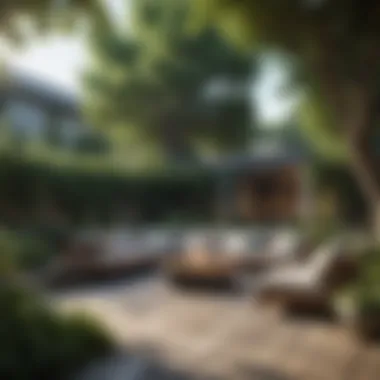
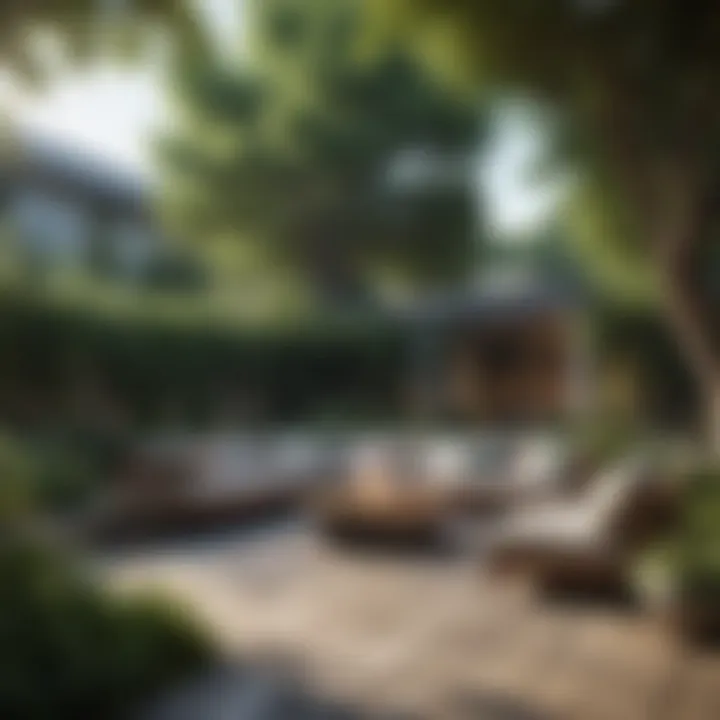
Embracing low-cost landscaping options can yield numerous advantages. Firstly, such choices can significantly reduce upfront costs, allowing for more extensive landscaping endeavors within the same budget. Homeowners can explore alternatives that look attractive without the premium price tag. For example, using recycled materials or local resources can provide unique aesthetics and save money.
Another benefit is the environmental impact. Often, low-cost options, such as native plants, contribute to sustainability. Native plants typically require less water and maintenance, making them a smart, eco-friendly choice.
Some additional advantages of low-cost landscaping options include:
- Flexibility: Homeowners can be more experimental without the worry of large investments.
- Community Engagement: Participating in local gardening initiatives can offer access to resources and knowledge.
- Creativity Boost: Working within a budget often spurs innovation and new ideas for unique designs.
Adopt a mindset that prioritizes functionality and aesthetics over mere expense. Each choice shapes the overall environment.
Ultimately, the benefits of low-cost landscaping build a foundation for a sustainable and enjoyable outdoor space that can cater to diverse personal tastes without the burden of financial strain.
Assessing Your Backyard Space
Assessing your backyard space is a critical step in executing a successful landscaping project. Understanding the dimensions, layout, and unique features of your yard allows you to make informed decisions that align both aesthetics and function. Without a thorough assessment, you might invest time and resources into elements that do not complement your overall landscape vision. This section serves as a cornerstone for practical landscaping approaches, setting the stage for informed planning.
Analyzing Size and Layout
The size and layout of your backyard will significantly influence your landscaping options. First, measure the total area to understand the space available. Divide the yard into smaller sections for a clearer picture of each area. Consider the following factors during your analysis:
- Shape: Is your yard rectangular, triangular, or irregularly shaped? Each shape offers distinct challenges and opportunities.
- Zoning: Identify areas that receive varying amounts of sunlight throughout the day. This is essential for choosing the right plants.
- Access: Think about how people will move through the yard. Pathways should connect different areas smoothly.
These elements will guide you toward optimizing the space. For example, you may find that a smaller area could serve as a cozy seating nook or a vibrant flower bed. Understanding your layout helps you maximize functionality while staying within budget.
Identifying Key Features
Every backyard has specific key features that can serve as a foundation for your landscaping design. Identifying these features not only adds character but also helps in making strategic decisions. Consider the following aspects:
- Existing Structures: Features like patios, decks, or fences should be incorporated into your design. They provide a base from which to build out further landscaping.
- Natural Elements: Look for trees, shrubs, or notable terrain that can enhance your landscape. For instance, a large tree can provide shade and serve as a focal point.
- Water Sources: If your yard has a pool, pond, or a drainage area, these will affect what types of plants and materials you can use.
By understanding these key features, you can create a cohesive landscape that maximizes beauty while ensuring practicality.
Ultimately, a well-thought-out assessment serves as the backbone of your landscaping project.
"An effective landscaping plan begins with an accurate assessment of the space and its features."
This groundwork will enable you to develop a thoughtful, budget-conscious approach to your landscaping needs.
Creating a Landscaping Plan
Creating a landscaping plan is a foundational step for homeowners looking to enhance their backyard without incurring excessive costs. An effective plan not only outlines the layout for planting and hardscaping but also sets priorities based on the functionality and aesthetics desired. By conceptualizing the garden space, one can better allocate resources, preventing wasteful spending and ensuring that the design meets personal needs.
Several elements contribute to a successful landscaping plan. Firstly, understanding the available space is crucial. Large backyards can often feel overwhelming, but with a structured plan, they can be transformed into inviting outdoor environments. This means considering the overall style, the types of plants suitable for the climate, and how to integrate features like paths or seating areas effectively.
Additionally, setting a clear budget from the outset will help guide decision-making. It is beneficial to divide the plan into phases to manage costs better. For example, the initial focus could be on structural elements like patios and walkways, while planting can come later. This phased approach allows for adjustments based on available funds after completing each project phase.
Setting Clear Objectives
Clear objectives are vital when creating a landscaping plan. They provide direction and purpose, ensuring that every choice made aligns with your goals for the space. Begin by determining what you want to achieve with your backyard. Is it for entertaining guests, providing a play area for children, or creating a peaceful retreat?
Setting measurable objectives can be helpful. For instance, you might aim to have a specific number of seating areas or a distinct section for vegetables and herbs. Clearly defined objectives assist in the decision-making process, as they can guide selections of materials, plants, and features that align with your ultimate goal.
Consider also the long-term vision for the space. Will you want to host gatherings? Will there be kids running around? What about maintenance? Keeping these factors in mind will aid in developing a practical plan that meets current and future needs.
Incorporating Functionality
Incorporating functionality into your landscaping plan enhances the utility of your backyard while keeping costs in check. Functionality can mean many things depending on personal lifestyles and preferences. For instance, consider adding pathways that connect various areas of your garden. This not only improves navigation but also prevents trampling on grass or flower beds.
Another functional element is plant selection. Choosing native plants that thrive in your climate reduces the need for extensive upkeep. Such plants generally require less water and care, making them a cost-effective choice in the long run.
Moreover, think about outdoor living. Are you looking to cultivate a dining space outside? In that case, design the plan to include a patio or deck area that can comfortably accommodate furniture. This encourages more outdoor gatherings, adds value to your property, and creates a space to enjoy nature.
Selecting Cost-Effective Materials
In landscaping a large backyard on a budget, selecting cost-effective materials stands as a fundamental piece of the puzzle. Choosing the right materials influences not only the financial outlay but also the longevity and appeal of your outdoor space. This article will explore various options that save money while maintaining a pleasing aesthetic.
Selecting affordable materials allows homeowners to create a visually appealing garden that does not compromise on quality. The right materials can help to establish a cohesive design, enhance functionality, and prevent overspending. Additionally, cost-effective choices often align well with sustainability, making them both economically and environmentally sound.
Affordable Hardscaping Choices
Hardscaping refers to the non-plant elements of your landscape, such as patios, paths, walls, and decks. Choosing affordable hardscaping materials can yield significant savings.
- Concrete Pavers: Durable and visually appealing, concrete pavers can mimic more expensive natural stones while being less costly.
- Gravel: Gravel is a low-cost alternative for pathways and driveways. It provides excellent drainage and comes in various colors and sizes.
- Reclaimed Wood: Utilizing reclaimed wood for borders, fencing, or raised beds can add character to your garden while saving money and resources.
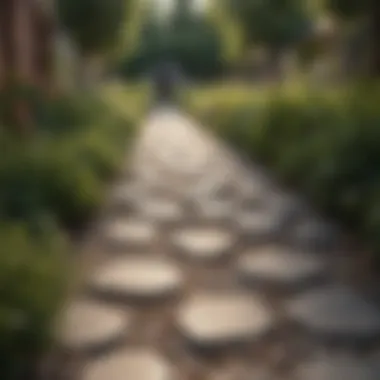
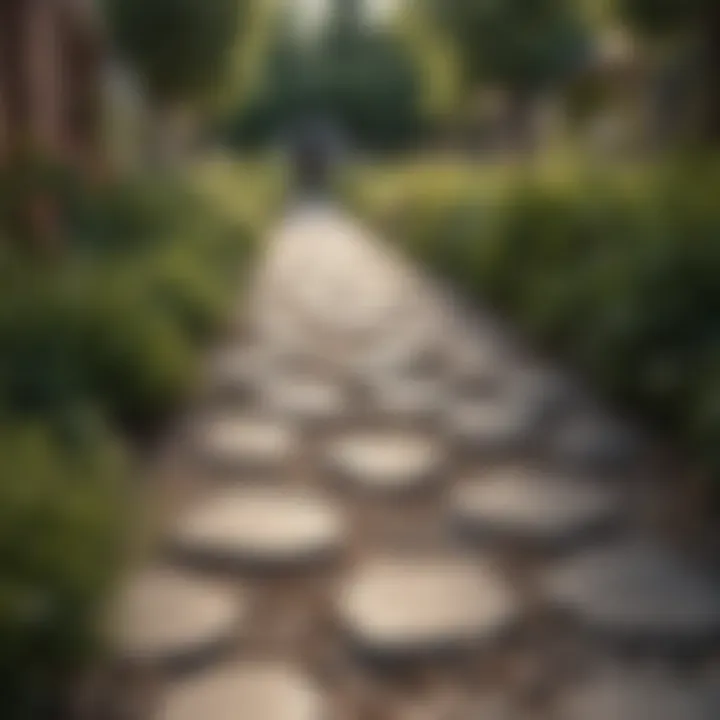
These materials not only fit within a tight budget but also stand the test of time, requiring less maintenance and replacement over the years.
Sustainable Materials for Landscaping
In today’s age, sustainability should be part of every landscaping project. Select materials that are environmentally friendly, reducing impact on the planet while keeping your costs in check.
- Bamboo: A strong and renewable resource, bamboo is often used for fencing or decorative elements. Its rapid growth makes it a sustainable choice.
- Recycled Rubber Mulch: This is a long-lasting option for flower beds. It decomposes slowly, and it can be made from discarded tires, which is a win for sustainability.
- Locally Sourced Stone: Using materials sourced locally reduces transportation costs and supports local businesses. It can also create a natural look that blends well with the surrounding environment.
Choosing Plants Wisely
Selecting the right plants for your backyard is essential in creating a cost-effective landscaping strategy. Plants not only enhance the visual appeal of the space but also provide various economic benefits over time. By making informed choices, homeowners can significantly reduce maintenance costs, save on water expenses, and enjoy the benefits of a thriving garden. This section will delve into the advantages of choosing the right types of plants and how those choices contribute to a sustainable and attractive landscape.
Native Plant Selection
Choosing native plants is a wise strategy for any landscaping project. Native plants are those that naturally occur in a specific region. They are adapted to the local climate and soil, making them easier to grow and maintain. These plants usually require less water and fertilizer than non-native varieties, reducing ongoing costs.
Native plants can lower maintenance and water usage, which is an essential factor for budget-conscious homeowners.
When selecting native plants, consider the following:
- Local Climate: Ensure that the plants you choose are suited to your area's weather patterns. For example, if you live in a dry region, opt for drought-resistant species.
- Soil Conditions: Different plants thrive in different soil types. Testing your soil can help you determine which type of native plants will do best.
- Biodiversity: By planting natives, you contribute to local biodiversity, supporting wildlife such as pollinators.
Some examples of native plants include:
- Purple Coneflower
- Black-eyed Susan
- Eastern Redbud
Incorporating these plants can create a beautiful environment while minimizing external inputs like fertilizers and irrigation.
Perennials vs. Annuals
Understanding the difference between perennials and annuals is crucial for budget-friendly landscaping.
Perennials are plants that live for more than two years. They typically require less frequent replacement, making them a cost-effective choice in the long run. Furthermore, many perennials bloom year after year, adding consistent beauty to your space without significant reinvestment.
Annuals, on the other hand, complete their life cycle in one season. While they can provide vibrant color, replacing them every year can lead to additional costs over time.
When making a decision:
- Budget: Consider how much you are willing to invest initially and over time. It may be sensible to focus more on perennials to cut down on yearly costs.
- Color Scheme: Annuals can offer a broader variety of colors and blooms but might stretch your budget.
- Growth Speed: If you want immediate impact, annuals grow quickly. However, eventually, perennials will fill your space as they mature.
In summary, choosing wisely between perennials and annuals can help you manage costs while achieving a lush and beautiful garden.
By carefully selecting plants that are native and evaluating whether to use perennials or annuals, you can create an impressive backyard that aligns with both your aesthetic preferences and budget constraints.
Implementing DIY Solutions
Implementing Do-It-Yourself (DIY) solutions in landscaping can significantly reduce costs while allowing for personal creativity. By engaging in DIY projects, homeowners can transform their outdoor spaces to reflect individual style without needing to hire professional landscapers. Furthermore, these projects can foster a sense of accomplishment, as well as a deeper connection to the home environment. It is also crucial to recognize that some DIY projects, such as building raised garden beds or creating simple paths, require minimal tools and can be completed over a weekend.
While the cost savings are clear, another important consideration is the learning opportunity that DIY solutions provide. Homeowners can acquire new skills and knowledge about plants, materials, and landscape design, which can prove valuable for future projects. This hands-on experience often results in a better understanding of the natural elements of their yard. Ultimately, implementing DIY solutions can be a rewarding and educational journey that enhances both the landscape and the owner’s skills.
Simple Projects to Start With
When beginning with DIY landscaping, it is advisable to choose projects that are manageable and impactful.
- Raised Garden Beds: These structures are practical and can be constructed with wood or stone. They promote an organized layout and improve drainage.
- Mulch Paths: Creating paths using wood chips or gravel can be a cost-effective way to define walking areas in your garden.
- Container Gardening: This option allows flexibility and can be done with minimal investment. Using recycled containers enhances the aesthetic as well.
- Simple Fire Pit: A fire pit can be an inviting feature for outdoor gatherings. Using bricks or stones, one can create a basic fire pit with relative ease.
- Birdhouses or Feeders: Constructing and placing these elements not only beautifies the garden but also attracts wildlife, creating a vibrant ecosystem.
Starting with these projects can motivate homeowners and give them the necessary direction to tackle larger tasks later on.
Helpful Tools and Resources
Equipping oneself with the right tools is essential for successful DIY landscaping
- Basic Tools: A shovel, rake, and gardening gloves can get most simple projects underway. These tools are cost-effective and widely available.
- Online Resources: Websites like Wikipedia and Britannia can provide valuable information about sustainable landscaping practices and plant care. For community engagement, platforms like Reddit and Facebook groups focused on gardening can offer practical advice and share experiences from other gardening aficionados.
- Instructional Videos: YouTube hosts a variety of tutorials. Watching these can provide visual guidance that might be easier than reading instructions.
- Local Hardware Stores: Many local stores offer workshops. Categories cover everything from planting tips to building garden structures. These sessions can be both informative and motivating.
Engaging with these tools and resources can ease the mental barriers associated with starting DIY landscaping projects. By arming oneself with knowledge and supplies, transforming a large backyard into a dream space can be a reality.
Maintaining Your Landscape
Effective landscape maintenance is essential for ensuring that your outdoor space remains both beautiful and functional over time. This section emphasizes how regular upkeep can greatly enhance the longevity of landscaping investments while reducing overall costs. For homeowners with large backyards, understanding and implementing maintenance strategies not only keeps the garden looking appealing but also increases property value. Moreover, well-maintained landscapes contribute to environmental sustainability by promoting healthy ecosystems.
Cost-Efficient Maintenance Tactics
To maintain a landscape without overspending, it is vital to adopt cost-efficient maintenance tactics. Here are several strategies that can conserve resources and money:
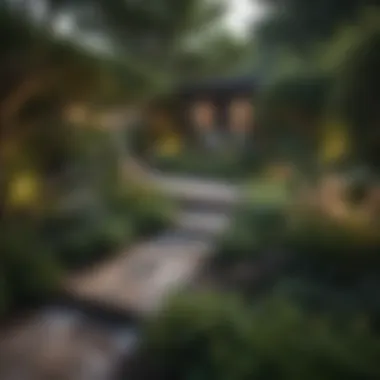
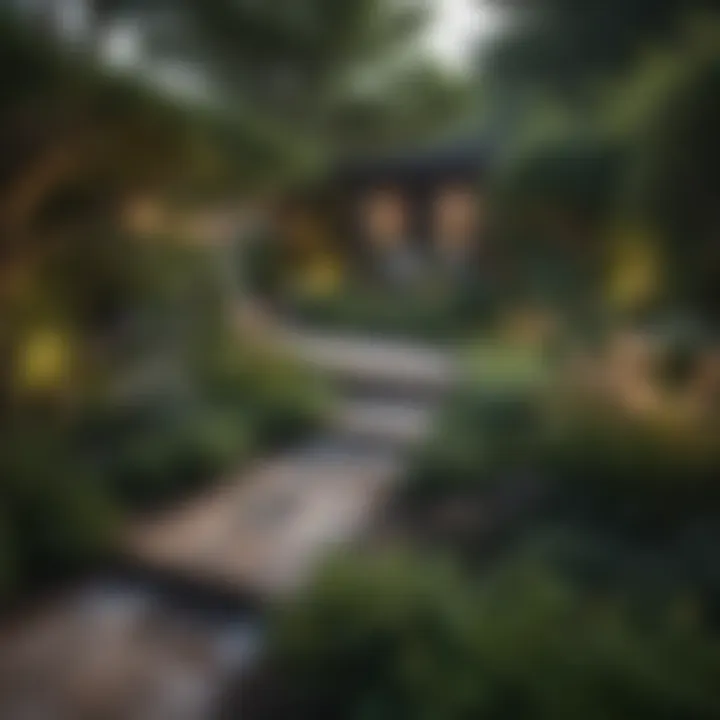
- Mulching: Adding mulch around plants helps retain moisture, suppress weeds, and improve soil quality. Opt for organic mulch such as bark or wood chips, which can also decompose and enrich the soil over time.
- Regular Pruning: Prune trees and shrubs at least twice a year to prevent overgrowth and promote healthy growth. Regular trimming saves money on potential tree service fees for larger, unmaintained plants down the line.
- Water Efficiency: Implement a rainwater collection system. Using rain barrels can reduce your reliance on municipal water supply for irrigation, thereby cutting water bills.
- DIY Repairs: Take on minor repairs or updates yourself instead of hiring professionals. Simple tasks like fixing pathways or repainting fences can often be handled with basic tools and materials.
- Tool Care: Maintain all gardening tools with regular cleaning and storage practices. Keeping them in good condition ensures longevity and helps avoid sudden replacement costs.
"A little maintenance can go a long way in preserving the beauty of your outdoor space."
Seasonal Care Guidelines
Seasonal care is crucial for adapting your maintenance practices to the changing needs of your landscape. Here’s a breakdown of important seasonal tasks:
- Spring: Begin with a thorough cleanup of debris and dead plant material. Fertilizing at this time can encourage new growth. It's also an ideal time for planting.
- Summer: Focus on consistent watering, especially during dry spells. Deadheading flowers will encourage more blooms and keep the garden looking tidy.
- Fall: Prepare your garden for winter by applying mulch and protecting delicate plants. This season is also best for planting spring-blooming bulbs.
- Winter: Check landscaping structures for any damage caused by weather conditions. Pruning trees and shrubs should be done during this time to prepare them for spring growth.
By keeping a regular maintenance schedule that aligns with seasonal needs, homeowners can sustain the health and beauty of their landscaping while also being cost-effective.
Incorporating Outdoor Living Spaces
In the realm of landscaping, incorporating outdoor living spaces is more than just an aesthetic enhancement. It serves as a bridge between indoor comfort and the natural world. For homeowners with large backyards, this incorporates various elements such as patios, decks, and outdoor furniture. These features not only expand living space but also encourage outdoor activities. They allow for social gatherings, relaxation, and enjoyment of the beautiful surroundings. The importance of these areas cannot be overstated, as they create functional spaces that enhance the usability of the backyard while remaining cost-effective.
Designing Patios and Decks
When considering the design of patios and decks in a large backyard, it is critical to assess the layout. A well-placed patio can act as the centerpiece of the outdoor space. It is usually best to choose a location that gets sufficient sunlight while still providing some shade. Options such as concrete, brick, or natural stone are common materials for patios. The right choice depends on budget, style, and durability.
Design should also integrate accessibility and flow. Pathways leading to the patio should be clear and logical. Think of how you use the space. For example, if entertaining is a priority, a larger deck or patio where furniture can be arranged for seating and dining is helpful. Incorporation of small elements, like built-in planters, can enhance the overall design without breaking the bank.
Selecting Affordable Outdoor Furniture
Affordable outdoor furniture is crucial for transforming a backyard into a functional living space. Homeowners often think outdoor furniture needs to be expensive, but that is not the case. Materials like plastics and composite woods can offer durability at lower prices. Look for options available at stores like IKEA or Target that provide great value.
When selecting outdoor furniture, consider how much space you have. A smaller area necessitates multi-functional pieces, such as benches that can double as storage. Additionally, search for second-hand options. Thrift stores or platforms like Facebook Marketplace can yield valuable finds.
Comfort is also a priority. Choosing cushions made with water-resistant fabrics can prolong their life and increase the enjoyment of the space. Ultimately, the correct outdoor furniture complements the design of patios and decks, ensuring that they are not just beautiful but also practical.
Incorporating outdoor living spaces adds aesthetic value and enhances functionality, turning a plain backyard into a loved retreat.
Engaging the Community
Engaging the community in landscaping efforts offers several key advantages for homeowners with large backyards. By involving neighbors and local organizations, individuals not only enhance their immediate environment but also foster a sense of unity and shared responsibility. This engagement promotes awareness of the importance of green spaces and allows residents to share resources, ideas, and support. Community involvement can lead to more inclusive, diverse landscapes that reflect the unique character of the neighborhood.
In addition to beautification, community involvement in gardening initiatives can reduce costs significantly. By sharing tools, plants, and even labor, individuals can stretch their landscaping budgets further. Community initiatives often lead to the establishment of shared gardens or beautification projects that benefit all participants. This communal approach minimizes individual effort while maximizing the impact of landscaping through collaboration.
Engaging with neighbors and local organizations builds social connections that can lead to lasting friendships and deeper ties within the community. It also promotes sustainability by encouraging the use of local resources and plants suited to the climate and soil of the area.
"Creating a strong local network through gardening brings people together and improves the neighborhood's aesthetic appeal."
Utilizing Local Resources
Utilizing local resources is an effective strategy for cost-effective landscaping. From nurseries to home improvement stores, local businesses often provide resources at a lower price, especially when compared to national chains. By sourcing materials like soil, plants, and stone locally, homeowners can save on transportation costs while also supporting the economy in their community.
Additionally, local plants are usually better adapted to the local climate and soil conditions. These plants often require less maintenance, fewer resources, and are more resilient than exotic species. Engaging with local garden clubs or horticultural societies can provide valuable insights into the best choices for your specific backyard. These organizations often have knowledge on where to source affordable materials and plants that thrive in the region.
Exploring farmers markets is also an excellent option. Many markets feature vendors that sell plants and landscaping materials at competitive prices. The added benefit here is that one can often enjoy the experience of meeting the growers, gaining insight into how to properly care for the plants, and fostering local relationships.
Participating in Community Gardening Initiatives
Participating in community gardening initiatives can significantly enhance the landscape of large backyards while promoting social and environmental benefits. Community gardens are shared spaces where individuals can grow fruits, vegetables, and flowers. They typically rely on volunteer effort and provide an opportunity for people of various backgrounds to bond over a common interest.
These initiatives not only improve aesthetics but also create educational opportunities regarding sustainable gardening practices. Workshops and events often accompany community gardens, allowing participants to learn about permaculture, composting, and organic gardening methods. This exchange of knowledge can help homeowners apply these eco-friendly practices in their own gardens.
Moreover, community gardens often implement permaculture designs, which integrate plants in a way that creates a self-sustaining ecosystem. By joining these initiatives, homeowners can gain practical experience and confidence in their own landscaping projects. This ultimately leads to personal satisfaction and pride in one's gardening capabilities.
To find gardening initiatives, one can check local bulletin boards, social media groups, or websites dedicated to community events. This way, individuals can become part of a broader movement that not only beautifies spaces but builds a sense of community and cooperation.
Evaluating Your Landscape's Progress
Evaluating your landscape's progress is a crucial step to ensure that your landscaping efforts meet both aesthetic and functional goals. This analysis allows homeowners to assess whether their investment in landscaping is producing the desired outcomes. It also provides an opportunity to identify areas needing improvement and recognize which elements are thriving. The primary objective behind assessment is not just to validate the initial efforts but to foster an adaptable landscape that continues to flourish over time.
Setting Performance Metrics
Setting performance metrics involves determining specific criteria against which the success of your landscape can be measured. These criteria may include:
- Plant Growth: Evaluate how well plants are thriving based on growth rates, foliage color, and overall health.
- Functional Use: Assess how efficiently the landscape meets functional aspects like outdoor entertaining, play areas for children, or quiet spaces for relaxation.
- Visual Appeal: Regularly analyze whether the landscape maintains its visual harmony and attractiveness. This includes checking if colors and textures are balanced.
- Cost Efficiency: Monitor maintenance expenses to ensure they align with budgeted amounts.
By establishing these metrics, it is possible to quantitatively gauge the effectiveness of landscaping choices. This structured method allows homeowners to make informed decisions moving forward.
Adjusting Based on Feedback
Adjustment based on feedback is essential to enhance the landscape's quality continually. This process involves both personal observations and potential input from family and friends. Here are some considerations for a successful adjustment process:
- Observation: Regular check-ups on plant health and landscape functionality will provide insight into what is working well and what is not.
- Community Input: Engaging friends or neighbors for their viewpoints can offer new ideas or highlight issues you might not notice. Sharing experiences on platforms like Reddit can also provide a broader spectrum of feedback from various gardening enthusiasts.
- Experimentation: Don’t be afraid to try new plants or rearrange existing features. Change can lead to surprising benefits.
- Documentation: Keeping a journal of changes and observations can assist in tracking what works best in your landscae.
Ultimately, evaluating progress involves a continuous loop of assessment and revision. By being responsive to the changing landscape and adapting based on well-defined metrics, homeowners can cultivate a vibrant and lasting backyard environment.



